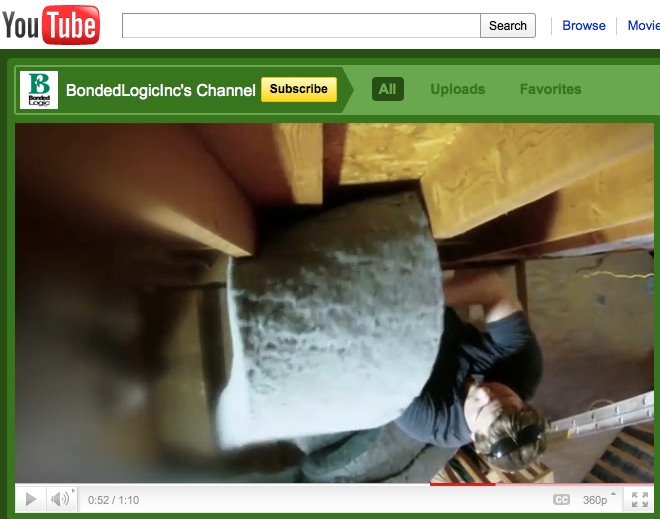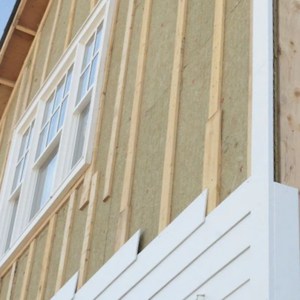
Image Credit: Bonded Logic
What do you do when a green product doesn’t live up to expectations? I want to see green building products succeed in the marketplace, and make it easy for professionals to find the best of the best in our GreenSpec guide.
So I’ll say it up front: when I see a product being marketed as green that’s substandard, I think it’s important to point it out. This doesn’t mean the product has problems because it’s green. It means that I hold it to a higher standard: to win the mainstream over to sustainability, we have to deliver on promises of reduced environmental burdens along with superior performance.
A little while back, I took Bonded Logic to task for flaws its Ultratouch cotton batt design and installation process.
The problems with Ultratouch
The worst flaw I found was that the product is too thin. After being compressed in bags for shipping from Ultratouch’s Arizona plant, the post-consumer-denim cotton batts never regain their “loft.” That means that insulation is going into wall and ceiling cavities with air spaces around it. Air that is completely stagnant insulates very well — at R-5, even better than Ultratouch’s R-3.7. But air in wall cavities moves around with convection, contributing to heat loss and crippling the nominal R-value of the insulation. (Read more here on How Insulation Works.)
I also found that the batts were too wide for 16-inch-on-center KD 2x4s (standard lumberyard kiln-dried sticks), leading again to air spaces due to poorly fitting batts.
Thirdly, I complained that the batts were really hard to cut. This was especially frustrating because the ill-fitting batts required a lot more cutting than a standard fiberglass batt.
The good news is that Bonded Logic is now perforating its batts at standard widths so that they are easier to cut for proper fitting. They haven’t announced what those widths, are, however, and it seems like a tough problem. How standard are the sizes of the off-size stud cavities found in our buildings? Perhaps in new homes with designs optimized for manufactured material use they are standard, but in the retrofits and custom jobs that a lot of builders are doing today, I am not sure how useful these perforations will be.
Another piece of good news, according to a spokesperson I heard from, is that Ultratouch will also soon be available in different widths according to whether you’re using wood or steel studs.
Bonded Logic still doesn’t get it
However, Bonded Logic still doesn’t seem to get it when it comes to installation quality. Whether you’re using fiberglass or cotton batts, exact fitting to cavity sizes is key. That means cutting insulation around electrical boxes, wiring, and also cutting it for the occasional cavity of a different dimension. What I’ve seen of this installation video is pretty good, but there’s a flub in the Bonded Logic video publicizing its new perforated batts. As the screen capture shows, the installer is placing a batt in a cavity with complete disregard for the unusual shape of the cavity. The installation will result in a classic poor batt installation — lack of complete contact with all six sides of the cavity. What kind of attention are they putting into other irregular cavities?
I brought up this issue with the same Bonded Logic spokesperson in two successive emails, and did not receive a response. That was a couple months ago. The video is still up, so I’m taking Bonded Logic to task again.
The real installation culprit: fiberglass
To be clear, I like cotton insulation for several reasons, including Bonded Logic’s recent move to post-consumer recycled jeans (previously it was pre-consumer denim), and the fact that it’s much less unpleasant than fiberglass to work with — although unlike the folks in their videos I would still wear a mask to protect from dust that comes off the product, particularly during cutting. Also, by focusing my ire on cotton I don’t intend to give a pass to what I see as the real culprit in batt insulation: fiberglass.
Fiberglass batts have been poorly installed by so many people in so many buildings for so many years — to the extent that GBA’s own Green Curmudgeon called for it to be banned. It can even be argued that fiberglass is less tolerant of the kinds of questionable installation choices seen in its manufacturers’ videos (I’m referring to the questionable approach to ductwork and piping) because it is relatively air-permeable, so air has an easier time forming currents through gaps created during poor installation. See this guide on GBA for signs of a good batt install.
All the more reason, though, that we need to do better in the green products community.
What do you think? Please leave your comments below.
Weekly Newsletter
Get building science and energy efficiency advice, plus special offers, in your inbox.















5 Comments
Superior secondary insulation
I personally like Demin insulation for sound improvement in ceilings and walls. Also we are looking to use it to fill part of an installation wall (which I think every house should have). Doing that I do not believe convection plays such a big role, because it is enclosed by the air barrier (taped plywood) and the drywall. This leads to an earlier discussion on this blog ( https://www.greenbuildingadvisor.com/blogs/dept/musings/one-air-barrier-or-two ), if two air barriers are necessary. My opinion on that is: Not needed to get the house tight but helps to prevent convection if batt insulation is used.
One thing I think a lot of people are confused about is your statement that completely stagnant air has a R- value of 5. I saw builders actually advertising with this. I know here in the US nobody seems to work with the value lambda describing the thermal conductivity of a material without the effect of it`s thickness and as the name says without the convection influence! I think this is a very useful value and air, still or not, has a lambda of 0.025 W/(m K) which ignorantly translates to R-5/in . With the influence of the thickness and convection still air never exceeds R- 1.
The thermal conductivity of
The thermal conductivity of truly still air increases with temperature. At room temperature, the conductivity (lambda) is indeed around 0.025 w/mK, but conductivity at room temperature is of little interest as far as insulation goes, since temperature difference and thus heat transmission therefore are nil. At 0 F, the conductivity is around 0.023. Multiplying either by 6.93347 gives BTU-in/ft2-hr-F, and taking the reciprocal of that gives R in English units. Thus R ranges from around 5.7 to 6.3 for truly still air in the temperature range of interest (for a heating climate).
Saying "With the influence of the thickness and convection still air never exceeds R- 1" is misleading. If there is convection, the air isn't "still" anymore. Granted, keeping air truly still is an elusive goal. Porous insulating materials work by intercepting air at very tiny intervals to retard convective flow that occurs by pressure gradient either across the layer or induced within the layer by air density differences. The relatively high R of the dead air films around the particles is offset by the higher conductivity of the particles of the insulating material itself and by any convective flow occuring within the layer.
Cotton Insulation
I predict cotton insulation will shrink. If it can be kept perfectly dry then maybe not. Let’s think about this, if we add small amounts of moisture nearly every day and then bake it. Do this for years and see if it is the same size 30, 40 or more years from now.
pre-shrunk?
Andy, that's an interesting thought, but I doubt it would shrink very much, if at all, for a couple reasons. One, it is made of recycled denim—which has already been exposed to water quite a lot. Cotton seems to do most of its shrinking in the first wash. Two, the cotton is fiberized at the plant, mixed with polyester and polyolefin, and baked at 350 degrees F. I think that plastic content would help prevent shrinkage, just like it does in clothing -- maybe even more so since the cotton fibers are so small in the insulation.
This would be interesting to test, though. Maybe I should run a sample through the wash? Err... maybe not.
Agreed or disagreed?
Dick, I doubt nothing of what you commented on and are actually well aware of the excellent insulation value of air and how insulation material makes use out of it. Why I gave the Lambda value at room temperature is because if we actually calculate with it, the air layer is close to the inside with lots of insulation material on the outside. This brings the "insulating" air closer to room temp than 0ºF and there is still heat transmission. But anyhow not really that important 0.023W/(mK) vs. 0.025W/(mK) the truth is somewhere in between.
Sorry for using the misleading word still... I should have put it in quotation marks. So do you agree with me that an air layer never reaches a higher R-value than 1?
R-values have a thickness that goes with them. R/in obviously takes care of that and with the common insulation materials that is no problem. Now with air or any other gas (as we both agree) that is huge deal. I think that saying "R ranges from around 5.7 to 6.3 for truly still air" is easy to misunderstand to many out there (not wrong).
I appreciate your input
Log in or create an account to post a comment.
Sign up Log in